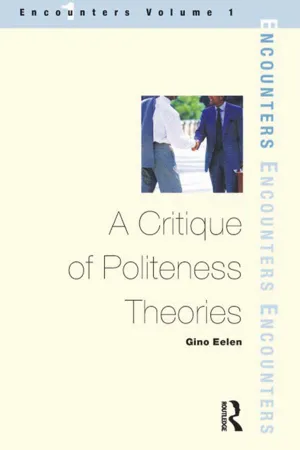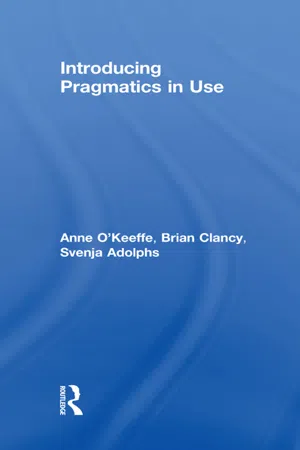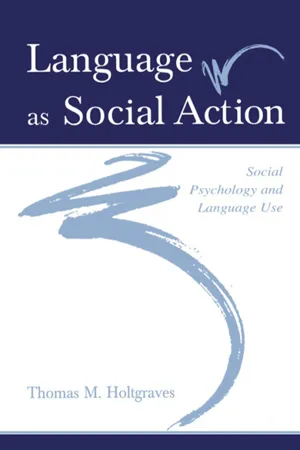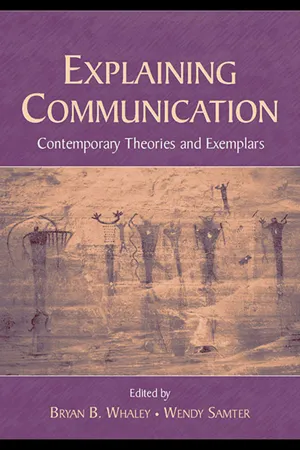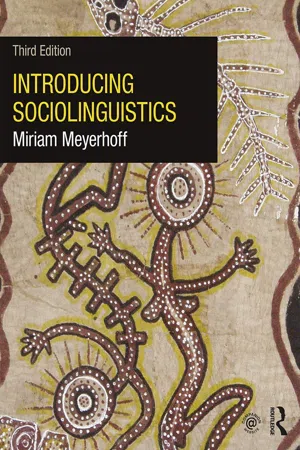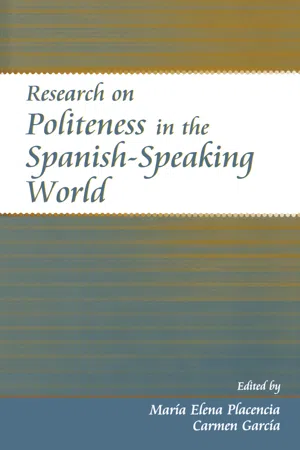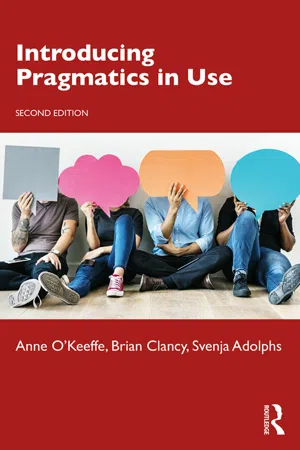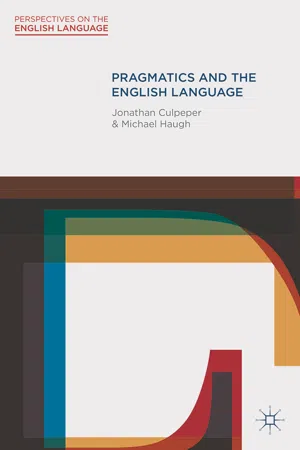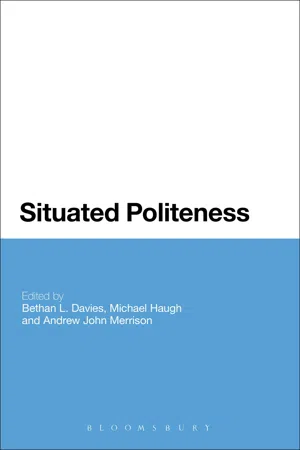Languages & Linguistics
Politeness Theory
Politeness Theory, developed by sociolinguists Penelope Brown and Stephen Levinson, explores how individuals use language to maintain social harmony and avoid conflict. It emphasizes the role of politeness strategies in communication, such as using indirect speech acts or mitigating language to show respect and consideration for others. The theory is influential in understanding the cultural and social aspects of language use.
Written by Perlego with AI-assistance
Related key terms
12 Key excerpts on "Politeness Theory"
- eBook - ePub
A Critique of Politeness Theory
Volume 1
- Gino Eelen(Author)
- 2014(Publication Date)
- Routledge(Publisher)
Chapter 1: Theories of politenessWithin the Anglo-Saxon scientific tradition, politeness research is carried out from the perspective of linguistic pragmatics and sociolinguistics. All theories considered here agree they belong to either of these linguistic subfields, the consensus deriving from the fact that politeness has to do with language, and more specifically language use – which warrants its classification within pragmatics – and that it is a phenomenon which connects language with the social world – which warrants the ‘socio-’ prefix. So although the pragmatic and sociolinguistic perspectives can to a greater or lesser degree be distinguished from one another depending on their exact definition and delimitation, for the present discussion they unite the field of Politeness Theory, in that politeness is invariably seen as a phenomenon connected with (the relationship between) language and social reality.Beyond this general level, however, agreement is much harder to find, as each theory more or less has its own (private) definition of politeness. In fact, the vast majority of publications on politeness contribute to some extent to theory formation on the subject. In order to reduce this mass of theoretical claims and innovations to manageable proportions, a selection has to be made. And it appears, in the light of the search for underlying linguistic and social ideologies, not all theoretical claims are equally important. On this basis, many theoretical amendments and innovations to existing theories can be excluded because the changes they propose do not touch the linguistic or social presuppositions of the existing theory on which they are based. Likewise, theories that are based on the same presuppositions as other theories can be left out. In such cases only the oldest or most widely known framework is retained. On the other hand, a theory that perhaps only tackles a small aspect of politeness but does so by introducing elements that significantly distinguish its social worldview from that of other (more encompassing) frameworks is retained in the final selection. So neither size nor renown were used as criteria in their own right, and therefore the term ‘theory’ must be taken in rather a broad sense, as it may refer to more or less elaborated models of politeness; that is to say, not all theories are equally well-developed, nor elaborated to the greatest possible detail. - eBook - ePub
- Anne O'Keeffe, Brian Clancy, Svenja Adolphs(Authors)
- 2011(Publication Date)
- Routledge(Publisher)
CHAPTER 4
4. Politeness in Context
4.1 THE LINGUISTIC STUDY OF POLITENESS
In this chapter we set out to explore some of the most influential theories of politeness that are essential reading for those new to the area. However, before doing so, it is worth taking time out to examine your own intuitions about politeness. In her book Pragmatics and Discourse (2008), Cutting warns that in pragmatics, when we talk of politeness, ‘we do not refer to the social rules of behaviour, such as letting people go first through a door … We refer to the choices that are made in language use, the linguistic expressions that give people space and show a friendly attitude to them’ (pp. 44–5). Therefore, in your reflection on what you consider polite language to be, do you consider terms like sir or madam , which show respect towards a person, polite? Is using fixed expressions like please, thank you, excuse me or sorry polite, socially acceptable behaviour? Or is language which we use to avoid sounding too direct such as Would you mind awfully if I asked you to move? an example of language which you consider to be ‘distancing’ or ‘hypocritical’?Politeness is one of the most researched branches of contemporary pragmatics – Dufon et al. ’s (1994) bibliography of politeness research extends to 51 pages in small print and claims not to be exhaustive. Watts (2003) noted that his bibliography contained 1,200 titles and was growing weekly!The question of what constitutes polite and, indeed, impolite, language usage is one of the most researched topics in contemporary linguistics. This chapter examines two distinct seminal theories (or models) of politeness, and demonstrates key features of these models in context. The first, Brown and Levinson’s Politeness: Some Universals in Language Use (1978, reprinted 1987), is arguably the most influential model to date given that it has dominated the theory of linguistic politeness since it was first published. Brown and Levinson define politeness as a complex system for softening face-threatening behaviour. They view politeness as a phenomenon that can be codified, thereby enabling the linguist to measure politeness quantitatively. This can be done very effectively using corpus software. However, researchers such as Watts (1989; 2003) have shown that cultures have conflicting views as to what constitutes polite language use, particularly when it comes to impoliteness. His model, as outlined in his book Politeness , has emerged as perhaps the most prominent alternative for the examination of linguistic politeness. He argues that there is no linguistic structure that can be considered innately polite; rather, politeness arises from a negotiation between individual speakers and the context in which the interaction takes place. In addition to these theories of politeness, we will examine some of the growing literature on impoliteness, for example Culpeper (1996) and Bousfield (2008). Many theorists, such as Watts, now use the term (im)politeness - eBook - ePub
Language As Social Action
Social Psychology and Language Use
- Thomas M. Holtgraves(Author)
- 2013(Publication Date)
- Psychology Press(Publisher)
In this chapter, I consider some of the interpersonal underpinnings of language use, focusing particularly on single utterances (interpersonal under- pinnings of sequences of talk are considered in chap. 4). Two general issues are pursued. First, as described in chapter 1, Grice’s (1975) theory of conversational implicature has been an influential framework for examining conversational interaction. He proposed the existence of a set of maxims that serve as a framework for the production and comprehension of indirect meanings. But why do speakers violate these maxims in the first place? Why don’t people speak in the clearest and most efficient manner possible (i.e., in accord with the maxims)? Second, when maxim violations do occur, how is it that hearers are able to arrive at the precise meaning intended by the speaker? The general thesis I develop in this chapter is that these questions are related and can be answered only with reference to interpersonal considerations. For most of this chapter, I focus on the first question and hence deal with issues regarding language production, or why speakers phrase their remarks the way that they do. In a final section of the chapter, I consider the second question and deal with the role of interpersonal processes in language comprehension.POLITENESS AND LANGUAGE PRODUCTION
Politeness Theory has provided a major framework for examining the inter- personal underpinnings of language use. Now, in this tradition the term politeness refers not to a lay conception of politeness or a set of protocols regarding how one is to behave in different social settings. Instead, politeness is a technical term, a theoretical construct invoked as a means of explaining the link between language use and the social context. Politeness is an extremely broad phenomenon existing at the interface of linguistic, social, and cognitive processes. It refers (roughly) to the way one puts things and the way one puts things is a result of a speaker’s cognitive assessment of the social context. Because of its broad reach, politeness has been a topic of interest to scholars in a variety of disciplines, including anthropology, linguistics, philosophy, social psychology, cognitive psychology, communication, sociolinguistics, and others.Several theories of politeness have been proposed (see, e.g., Fraser, 1990). But by far the most popular approach was developed by Penelope Brown and Stephen Levinson. Their theory was originally published as a book chapter in 1978, and then reissued whole as a book in 1987 (with an introductory chapter summarizing relevant research). This theory has been extremely influential, and for good reason: It represents a framework for linking the major dimensions of social interaction with the ways in which people talk with one other. In this regard, it is truly a social psychological theory of language use. Because of its importance, the present chapter is structured around this theory. - eBook - ePub
Explaining Communication
Contemporary Theories and Exemplars
- Bryan B. Whaley, Wendy Samter, Bryan B. Whaley, Wendy Samter(Authors)
- 2013(Publication Date)
- Routledge(Publisher)
Although many of the claims in Politeness Theory have proven controversial or problematic, most scholars agree there are many strengths that make it worthwhile to know the theory and to continue to study the concepts and phenomena addressed in the theory. First, the theory has great heuristic value. Concepts from Politeness Theory help us to understand many different types of communication. By making bold, explicit statements about how concepts are related, the theory has inspired tests and applications that raise new questions about the linkages among language, identity, relational definition, and culture. A second strength of the theory is its broad scope. P.Brown and Levinson (1987) proposed that microscopic aspects of language were related to macroscopic variations in social power, distance, and culture and that language use resulted from a combination of culturally specific and universal processes. Although there are questions about the adequacy of their proposals, their theory encourages scholars to think about these linkages.A third strength of the theory is especially important for communication scholars. Politeness Theory is a different kind of model of communication than many of the theories we are accustomed to encountering in communication studies. In contrast to theories whose primary goal is to predict what people will say, Politeness Theory appears to be most useful as a model of how to communicate strategically. In this way, the theory can help us to generate different kinds of questions about communication. In contrast to thinking about what people usually do or are likely to do, the theory can help to redirect our attention to what people should do or can do if they want to be effective. It is likely to be most useful to us as a rational model (O'Keefe, 1992) or as a strategic inferential model (Jacobs, 1994) rather than a variable analytic predictive model. It can also direct our attention to the constructive and creative ways that communicators use language to enact identities and relationships over the course of an interaction, particularly if we recall the origins of the theory in Goff-man's (1967) concepts of face and face work. Rather than treating the communication situation as a fixed set of factors that determines communication, the concepts and reasoning embodied in Politeness Theory can help us to focus on the reciprocal relations between communication tasks, identities, relationships, language forms, and sequences.ADDITIONAL READINGS
Any reader with a deep interest in Politeness Theory should read the original work by P.Brown and Levinson (the 1987 reissue is especially useful because it includes a review of research and the authors' response). Other useful reviews may be found in R.Brown (1990) and Coupland, Grainger, and Coupland (1988). O'Keefe (1992) provided an especially useful interpretation of Politeness Theory. - eBook - ePub
Patient-centred Communication
Discourse of In-home Medical Consultations for Older Adults
- Kayo Kondo(Author)
- 2022(Publication Date)
- Multilingual Matters(Publisher)
Politeness: Some universals in language usage by Brown and Levinson has exercised widespread influence not only in arts and humanities but also in behavioural sciences such as cognitive psychology, adding to the understanding of social cognitive phenomena (Holtgraves, 2005). The classical work of Brown and Levinson’s model has remained influential in health professional education because of the clear utility. The Brown and Levinson’s theory assumes that linguistic politeness could be seen as a universal phenomenon, and its framework includes 40 linguistic strategies used by an ‘actor’ (a social member who is a fluent speaker of a language). However, this theory has drawn criticisms from numerous researchers, particularly from East Asian scholars, in terms of its theoretical construct, conceptualisation of face and variability in other languages. These critiques have led to further discussions on the issues and produced a large number of research evidence, contributing to further developments of Politeness Theory. One of the key publications, Locher and Watts (2005), focuses on the conceptualisation of ‘relational work’. Their claim provides an updated theory of politeness, proposing that politeness is a discursive concept and must be seen in relation to other types of interpersonal meaning. However, in a shift to the discursive approach to politeness, further debates have arisen, and the ‘utility’ of the notion of politeness has been questioned and re-examined (Haugh, 2007).This chapter presents the key concepts and features of face and linguistic politeness and explore the social and contextual variability in the relevant linguistic behaviours. The main critiques of the Politeness Theory in the early 1990s and the important debates surrounding ‘the discursive approach to politeness’ are discussed. I review contextual considerations, dealing with the concept of ‘individualism versus collectivism’ (Hofstede et al - eBook - ePub
- Miriam Meyerhoff(Author)
- 2018(Publication Date)
- Routledge(Publisher)
By focusing the definition on both the speaker and the hearer, and by reframing politeness in terms of value (necessarily culture specific), he has tried to retain the elements of Brown and Levinson’s approach that have had lasting appeal with the more cogent critiques. In the next chapters we move away from the discussion of how interpersonal factors constrain speakers’ choice of language. We will begin to look at how speakers use language as a means for organising and giving meaning to larger social groupings. We have seen that politeness is about satisfying the needs of individual speakers and addressees, but also that it is about satisfying social or cultural norms. Similarly, in the next chapters it is worth bearing in mind that generalisations about the orderliness of talk between subgroups in a speech community are only possible because of the orderliness of individuals in those groups. Further reading Kádár and Haugh (2013), Culpeper et al. (2017) – for surveys of research on politeness and theoretical approaches. Leech (2007, 2014) – another widely used framework for analysing politeness, with well-explained connections to pragmatic theory. Haugh (2013) – on how politeness works through implicatures. Holmes (2006), Holmes and Stubbe (2014) – on gender and politeness and on politeness in workplaces. Mills (2003) – also on gender and politeness, but requires more engagement with theory. If you are interested in this topic, the Journal of Politeness Research will be useful. Also a lot of the work in intercultural communication, e.g., Oetzel and Ting-Toomey (2013). - eBook - ePub
- Salvatore Attardo, Lucy Pickering(Authors)
- 2021(Publication Date)
- Wiley-Blackwell(Publisher)
5 Politeness5.1 Theories of Politeness
We should start with a distinction: it is fairly obvious that there is plenty of non-linguistic politeness, or politeness performed without using language: opening doors, letting people go first, surrendering one’s seat for elderly people on public transportation, and many other actions more or less codified. The boundary between politeness and common decency is fluid: is it polite to help someone carrying a large object by opening a door for them or is it just a small kindness? Activities such as letting people go first, helping old ladies cross the street, not mocking people with disabilities, sending holiday cards, and so on likewise may or may not be considered polite, but they are part of a category of pro-social behaviors; the stereotypical nature of these behaviors is deliberately emphasized by our choice of “typical” polite behaviors.Several areas of demeanor are socially codified (and show the same arbitrariness of linguistic codes: yawning, sneezing, coughing, belching, etc. are defined as “rude” gestures in Western societies). Etiquette, such as table manners, the position of silverware, the sending of flowers, and so on were, at least in some social groups, heavily codified and are still a marker of socioeconomic privilege.We are interested in and will primarily deal with linguistic politeness, which is not the same thing as politeness at large, despite Lakoff’s (1973, p. 303) claim that the rules governing both of them are the same. This point should be kept in mind while reading the rest of the chapter. Ultimately, politeness, like many other such categories, such as irony, madness, game, or leisure, is a “folk-concept” not to be confused with its scientific definition. For example, “madness” has no scientific or legal standing in the United States, where the courts use the term “insanity,” which is defined in the penal code. As for psychology, they use the terms “psychosis” and “psychopathology.” So the folk definition of politeness should not be confused with the scientific definition of politeness. In order to distinguish between the folk concept of politeness and its scientific definition, they have been relabeled Politeness1 and Politeness2, respectively (Eelen, 2001; Watts, 2005).1 - Maria Elena Placencia, Carmen Garcia-Fernandez(Authors)
- 2017(Publication Date)
- Routledge(Publisher)
Introduction: Models for the Study of (Linguistic) (Im)Politeness 1 María Elena Placencia Birkbeck College, University of London Carmen García Arizona State University The past two decades have seen rapid growth in the study of linguistic politeness in different languages and cultures, including the Spanish-speaking world, reflecting the centrality that the topic has rightly been accorded. As Watts, Ide, and Ehlich (1992a, p. 2) maintain, “politeness touches on issues that are crucial not only for the sociolinguist and social anthropologist but also in the life of every individual human being.” These are issues that pertain to the management of interpersonal relations and the accomplishment of goals in social interaction, or to how “human beings successfully manage interpersonal relationships to achieve both individual and group goals” (Watts et al, 1992a, p. 1). Reaching a better understanding of politeness phenomena has thus become a major enterprise undertaken by researchers in different disciplines concerned with the study of language in social interaction. The widespread interest in this area can be traced back to the work of Brown and Levinson (1978, 1987), particularly their 1987 publication, Politeness: Some Universals in Language Use, in which a detailed politeness model is presented, and claims for its universality are made (see below). Their work inspired many scholars, including Hispanists, to carry out empirical studies to test the hypotheses they put forward, and to provide descriptions of the politeness orientations of the particular speech communities studied. However, problems with some of Brown and Levinson’s basic notions and the application of their model were soon apparent. As a result, amendments and alternative models have been proposed- eBook - ePub
Workplace Writing
Beyond the Text
- Stephen Bremner(Author)
- 2017(Publication Date)
- Routledge(Publisher)
Chapter 1 , Bargiela-Chiappini and Harris (1996) make a distinction between inherent status, which “results from holding a powerful position … acknowledged by all members of the … community and beyond” and relative status, which is “enjoyed as a result of the power an individual can exercise in an interpersonal relationship” (p. 637). Those who hold inherent status have considerable leeway in terms of the language they can choose when it comes to framing messages. For the novice with no status, however, the choice is more limited and making the wrong choice can have problematic consequences. One thinks of the students who write to their professors with lines such as “Please feel free to contact me on 44535627 if you have any questions”, unaware of how inappropriate this is, given the power relations that usually exist between student and teacher. In the academy, the deployment of phrasing like this can be overlooked, while in the workplace, writing in this way can have more serious reverberations. But in addition to managing writing in power-asymmetrical situations, novices may be required to write persuasive messages to colleagues of similar status, which can also pose its own challenges. The task of the teacher is to make students aware of the ways in which language can be used in situation- and status-appropriate ways to get things done in workplace settings. It is a considerable task.Politeness TheoryAt the heart of any contemplation of language and power is the notion of politeness, a much-studied area. As with any phenomenon that has received the attention of numerous researchers, it is has been defined in different ways. For many, e.g. Lakoff (1975), Brown and Levinson (1987), politeness serves as a means of reducing the possibility of conflict, prompting Kasper (1990, p. 194) to suggest that perspectives of this kind see communication “as a fundamentally dangerous and antagonistic endeavor”. Other perspectives see politeness more as a form of consideration for others, for example, Watts (2003), who talks of the notion of “mutual cooperation” (p. 17); Sifianou (1992, p. 86) also stresses the mutual element, describing politeness “as the set of social values which instructs interactants to consider each other by satisfying shared expectations ” (original emphasis). In these definitions, we can see the idea that the conventions of politeness are both understood and expected by all parties, an idea summed up by Bremner: “politeness is about participants in an interaction following the rules and expecting that they will be followed” (2013a, p. 1).While there have been a number of key studies of the nature of politeness (e.g. Lakoff, 1973; Leech, 1983) no consideration of this topic seems to be possible without looking at the work of Brown and Levinson. Their 1987 book, Politeness: Some Universals in Language Usage - eBook - ePub
- Anne O'Keeffe, Brian Clancy, Svenja Adolphs(Authors)
- 2019(Publication Date)
- Routledge(Publisher)
Chapter 5Politeness5.1 Linguistic PolitenessIn this chapter we set out to explore some of the most influential theories of linguistic politeness that are essential reading for those who wish to research this phenomenon. However, before doing so, it is worth taking time to examine our own intuitions about politeness.Task 5.1 Polite LanguageWhat words do you most commonly associate with politeness? In what situations do you most frequently/least frequently use them?When we think about politeness, what do we consider polite language behaviour to be? For example, do we consider terms like sir or madam , which show respect towards a person, polite? Is using fixed expressions like please, thank you, excuse me or sorry polite, socially acceptable behaviour? Or is language which we use to avoid sounding too direct such as Would you mind awfully if I asked you to move? an example of language which might be considered ‘distancing’ or ‘hypocritical’? If someone told you to Have a nice day , how would that make you feel? We are all, linguists and non-linguists alike, acutely aware of the phenomenon of politeness and its implications for our everyday language use. Take, for example, extract 5.1 from the Spoken BNC2014.(5.1)In extract 5.1, the speakers equate politeness with a particular form thank you and a particular behaviour showing respect . Ironically, the speakers are discussing the overuse of thank you in service encounters, specifically in a café setting. This is ironic, as contemporary linguistic politeness literature informs us that service encounters, at least when the attention is focused on the business at hand, are where forms traditionally associated with politeness such as please and thank you most frequently occur (see e.g. House, 1988; Wichmann, 2005; Binchy, 2005). <$1>’s utterance a lot of the Chinese told me to stop saying thank you so much - eBook - ePub
- Jonathan Culpeper, Michael Haugh(Authors)
- 2014(Publication Date)
- Bloomsbury Academic(Publisher)
any positive belief. For example, amusing somebody is an interpersonal activity that is generally viewed positively, but it is not at all clear that it would normally be considered a matter of politeness. A key objective for researchers is to understand the subset of positive evaluative beliefs that count as politeness on a particular occasion. The concept of face (Goffman 1967) is one mechanism for trying to doing this. However, we are not convinced that face easily accommodates all politeness-relevant positive beliefs. People also have such positive evaluative beliefs about social organisation and behaviours within social organisations – how people should be treated; what is fair and what is not; and so on. Some of these morality-related beliefs are associated with politeness. Spencer-Oatey’s (e.g. 2008) Rapport Management framework does a good job of accommodating this array of evaluative beliefs, incorporating as it does the notion of sociality rights, although it will perhaps inevitably require further adjustments as our understanding of politeness continues to evolve in light of work that further teases out alternative emic perspectives on politeness.Linguistic politeness refers to linguistic or behavioural forms that are (conventionally) associated with contexts in which politeness attitudes are activated (this view is consistent with, for example, Terkourafie.g. 2001, outlined above). We acquire linguistic politeness from our experience of social interactions (e.g. Ervin-Tripp et al. 1990; Escandell-Vidal 1996; Snow et al. 1990). It involves the use of expressions that are both contextually appropriate and positively evaluated by the target (cf. Locher and Watts 2005). Remember the use of please, as discussed towards the beginning of this chapter. It is not used by anybody to anybody, or in any context, and when it is used it is generally considered interpersonally positive. The point about politeness routines/markers is that knowledge of both their appropriate context and their positive social meaning has become conventionally associated with the form. Of course, this does not mean that simply using a politeness routine/marker will result in politeness being achieved. Politeness always involves a contextual judgement; as is frequently pointed out, politeness is not solely determined by forms alone (e.g. Watts, 2003: 168; Locher and Watts, 2008: 78). Not only this, politeness is not some fixed value waiting to be retrieved. It emerges dynamically in interaction, and different participants may make different judgements. So, how do we tap into these judgements? It makes sense to examine the interaction in which they are mediated, as well as the broader societal milieu in which these interactions are situated, as, for example, happens in the interactional approach to politeness outlined in section 7.6 - eBook - ePub
- Bethan L. Davies, Michael Haugh, Andrew John Merrison, Bethan L. Davies, Michael Haugh, Andrew John Merrison(Authors)
- 2011(Publication Date)
- Continuum(Publisher)
1In this chapter, we first briefly describe how context has traditionally been approached in the theorization of politeness, before outlining the post-structuralist critique of these structuralist or Parsonian notions of context. This leads into an overview of how ‘situatedness’ in various guises has been increasingly drawn upon in the approaches to politeness and impoliteness that have emerged over the past decade. While these different approaches vary in their degree of commitment to a post-structuralist conceptualization of context, they are all united in treating im/politeness as a fundamentally situated phenomenon. In this sense, then, we are attempting to make explicit what has been a largely tacit assumption among im/politeness researchers to date. However, in drawing together these different approaches to situatedness it also becomes clear that it constitutes a complex, multi-faceted notion. The contributions in this volume offer a wide range of options, we believe, and thus can seed the long-overdue move to better integrating current theorizations of situatedness in politeness.2. Structuralist Approaches to Context in Politeness ResearchContext has traditionally been invoked in theories of politeness in two distinct ways. The first draws from folk understandings of different types of discourse or activity types. These are often given commonsense or vernacular labels, such as ordinary conversation, workplace meetings and interactions, classroom talk, broadcast/survey/employment interviews, debates, medical consultations and so on, or more specific labels, such as intimate talk, family dinner table conversation, troubles telling (or troubles talk), small talk, negotiation talk, consultation, advice giving and the like. The received view is that these different discourse and activity types have an influence on the way im/politeness arises. Or at least, such a view is presupposed through the way we, as researchers, frame our analyses as being restricted to a particular type of discourse or activity type. However, while such discourse and activity types are clearly an important dimension of analysis, there are no established principles for classifying contexts in this way. This has prompted a move to focusing on how
Index pages curate the most relevant extracts from our library of academic textbooks. They’ve been created using an in-house natural language model (NLM), each adding context and meaning to key research topics.
